2022 Hyundai Tucson Hybrid Review: Stylin' On You

FAST FACTS
| Engine: | 1.6L I4 Turbo w/ 1.49-kWh battery |
| Output: | 226 hp, 258 lb-ft (combined) |
| Transmission: | 6AT, AWD |
| US fuel economy (MPG): | 37/37/36 |
| CAN fuel economy (L/100KM): | 6.3/6.6/6.4 |
| Starting Price (USD): | $26,135 (inc. dest.) |
| As-Tested Price (USD): | $38,535 (inc. dest.) |
| Starting Price (CAD): | $29,524 (inc. dest.) |
| As-Tested Price (CAD): | $43,324 (inc. dest.) |
I think something might be stuck to the front bumper.
Fear not, now-panicked PR person reading this: nothing harmed the 2022 Hyundai Tucson Hybrid while I drove it. But on a Friday at rush hour, as the second child stops in the crosswalk to point directly at me, I get worried. In both instances, the parents nudge them along, but once they’re curbside, they turn around to check the Tucson out, too.
Get a Quote on a New Hyundai TucsonCompact crossovers might be the four-wheeled equivalent of bran flakes, such is their ubiquity. But with the Tucson, Hyundai is making a strong play for them to be cool—and for this to be the new leader of the class.
Let’s talk looks
Call it striking. Call it over the top. Whatever descriptors you want to hang off the Tucson, we can agree it’s unlike anything else in the segment. (For the record, I’m in the former camp.)
This hybrid tester comes in a dark shade of blue, but even that can’t subdue the styling. A shield-like front grille hides the LED running lights within its elements, only showing the Tucson’s “face” when lit. In a world where pop-up headlights can’t exist, this is the next-best thing.
The visual drama continues around the Tucson. Squared-off fenders give it a hint of ruggedness; I like how the rear fender’s reflector mirrors the notches in the fronts. The bit of bright work tracing the window line terminates in a similar design on the D-pillar, looking like an expensive knife. About the safest part of the Tucson’s design is its full-width taillight—we’re approaching critical mass with the feature these days. The bar connects a set of angular housings which ensure the Tucson is just as distinctive when it passes you as it was at the crosswalk.
Those concept car looks also hide the Tucson’s growth spurt. Half a foot longer at 182.3 inches (4,630 mm), the Tucson is also wider and taller than the model it replaces.
Cabin cool
The dimensional stretch pays off inside the Tucson. Front-seat passengers will find it easy to get comfortable, with seats offering a healthy range of adjustments. The bigger news is in the back, where the second-row bench can recline. With the combination of heated seats, 39.5 (1,004 mm) inches of legroom, and an enormous glass-panel roof, you won’t find any complaints from those in the back.
SEE ALSO: 2021 Hyundai Elantra Hybrid Review: Sneak AttackBack up front, it’s the Tucson’s dash design that continues to impress. The upper portion wraps around from the doors, before flowing into the main infotainment section like a waterfall. I love that the seat memory buttons are held within the chrome strips which tie the whole look together. Sure, they’re slightly more of a reach than had they been plunked on the armrest, but that’s boring. The two-tone color scheme of this top-trim tester also gives the whole dashboard some visual depth.
The 10.25-inch touchscreen and the climate controls below it are both angled ever so slightly towards the driver. Lower trims use an 8.0-inch screen. Both get standard Apple CarPlay and Android Auto, though the big one here still needs the cords to do it. Regardless, the native UI is quick and intuitive, with most everything a swipe or poke away. Hyundai’s soundscapes are present here, if you have the desire to drive around to the notes of folks crunching through the snow, or servers clearing glasses off a table. Hey, I won’t judge.
This top-trim hybrid has a few other notable interior changes. The climate controls are haptic instead of physical buttons; thankfully, they’re spaced out. There’s also a digital instrument panel, which incorporates Hyundai’s clever Blind View Monitor. Finally, the shifter is the push-button variety. I don’t like it either, but it’s necessary for Smaht Pahk.
Trunk space is a RAV4-beating 38.7 cubic feet (1,097 L), which is around 0.1 cubes (2 L) more than the gas model. Fold the second row flat and the Tucson will swallow 74.4 cubes (2,108 L)—about 0.4 (11 L) less than the gas model.
Mature, comfortable ride
It’s not a bad thing, but there’s a bit of a disconnect between how the Tucson looks and how it drives. The angular looks suggest it’s sporty, but from behind the wheel, the Tucson is all about comfort.
The Tucson is a peach on highways and city roads alike. There’s enough give to the sidewalls on those 19-inch tires to take the sting out of bigger bumps, while the suspension’s damping is finely judged, smoothing out any unwanted nastiness. It’s also impressively quiet, with very little road or wind noise making its way to the cabin.
SEE ALSO: 2021 Hyundai Santa Fe Hybrid Review: Happier as a HybridAiding in the Hyundai’s hush-hush nature is the hybrid drivetrain. This is the same basic setup as found in the Santa Fe I recently drove: a 1.6-liter turbo-four hooked up to a 59-horsepower electric motor. A 1.49-kWh battery provides the charge for the motor. Combined, system output is 226 hp and 258 lb-ft of torque. A six-speed automatic is the key ingredient, allowing the hybrid to drive just like a regular ICE model. There’s no drone, none of that CVT-style elasticity off red lights, and when you call for full power, the transmission will happily drop a gear or two. The brake pedal is also pleasantly progressive, despite featuring hybrid regeneration.
I averaged a little under 37 mpg (6.4 L/100 km) during my time with it, which is bang-on the estimates. It’s easy to coax the Tucson into EV-only mode in the city, but even still, for top mpg bragging rights, the CR-V, RAV4, and Ford Escape all post better figures.
Maybe the gas-only N Line delivers sharper driving dynamics. I don’t think many buyers will mind, anyway: the thrill-seekers are looking to premium brands for something this size.
Dollars and sense
The Tucson range begins at $26,135 ($29,524 CAD), including destination, for a front-drive SE model (called Essential in Canada). Standard features include cloth seating, LED front lighting with high beam assist, forward collision avoidance with pedestrian detection, lane-keep assist, 17-inch wheels, a pair of USB ports, and the afore-mentioned wireless phone mirroring.
SEE ALSO: 2020 Toyota RAV4 Hybrid Review: The Dependable OneThe mid-range SEL (Preferred) is next up the ladder, ringing in slightly more at $27,685 ($31,924). Here you’ll find adaptive cruise control, blind spot collision avoidance, rear cross-traffic alert, Hyundai’s BlueLink connected services, two more USB ports in the second row, a powered driver’s seat, and other goodies. Hyundai offers two options packages for the SEL. The $2,600 Convenience package brings in 19-inch wheels, a wireless charger, ambient lighting, a sunroof, power liftgate, and dual-zone climate control. Canada offers roughly the same bundle of kit in the $2,600 CAD Trend package. A $1,700 Premium package adds leather seating, ventilated front seats, and a Bose audio system. The N Line ($31,785 / $38,824 CAD with standard AWD) does its own thing with different styling and suspension tuning. That’s where the gas-only trim walk ends for Canada; America gets the $35,885 Limited.
AWD is a $1,400 ($2,000 CAD) charge across all trims. Like the hybrid versions of the CR-V and RAV4, the Tucson hybrid comes only with all-wheel drive. It comes with a reduced trim range: Blue, SEL Convenience (Luxury) and Limited (Ultimate). Opt for the latter like this tester and it’ll run $38535 ($43,324 CAD). It comes with all the goodies, including a huge panoramic sunroof, remote parking assist, 360-degree camera, and Highway Drive Assist.
Verdict: 2022 Hyundai Tucson Hybrid Review
The 2022 Hyundai Tucson is about as radical as a brand’s best-seller can be. Like it or loathe it, the styling demands attention. There’s real substance under those sharp creases, though. This compact crossover is loaded with the right mix of tech, comfort, and safety, all at a competitive price. With the hybrid model, buyers don’t quite get the fuel economy of the class’ top fuel misers, but the Tucson runs them close, and soundly beats them in refinement because of its transmission choice.
I’m still not sure any competitor in this segment can truly be cool. But I am certain the Tucson has just re-set the bar for the compact crossover segment. The kids are right.
Become an AutoGuide insider. Get the latest from the automotive world first by subscribing to our newsletter here.
LOVE IT
- Those concept car looks
- Comfortable, well-equipped interior
- Why doesn't every hybrid use an automatic transmission?
LEAVE IT
- Styling not to everyone's tastes
- Not as fuel efficient as other hybrids
- Not enough physical buttons inside—or in the wrong spot (like the shifter)

Kyle began his automotive obsession before he even started school, courtesy of a remote control Porsche and various LEGO sets. He later studied advertising and graphic design at Humber College, which led him to writing about cars (both real and digital). He is now a proud member of the Automobile Journalists Association of Canada (AJAC), where he was the Journalist of the Year runner-up for 2021.
More by Kyle Patrick



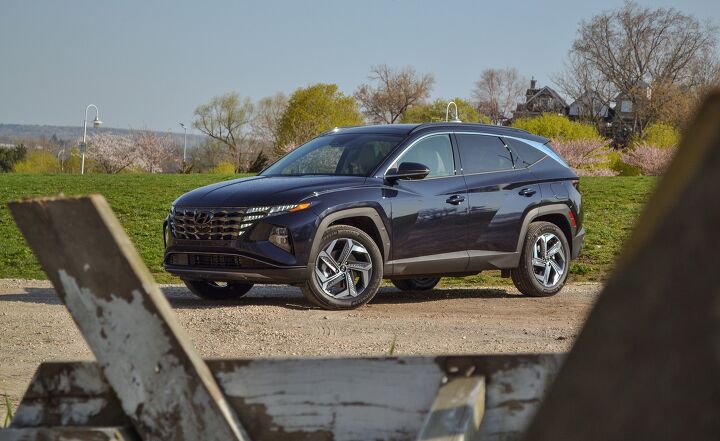



















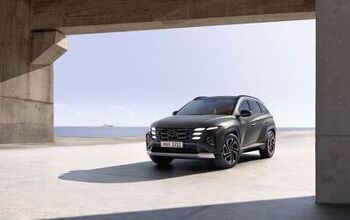
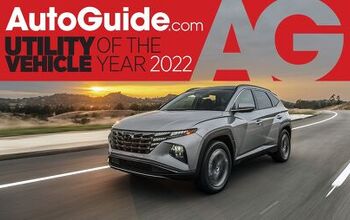
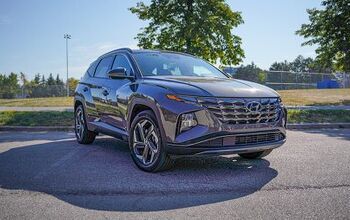


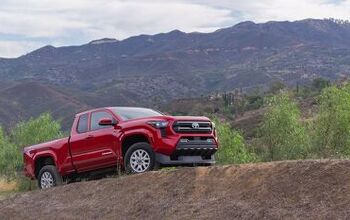
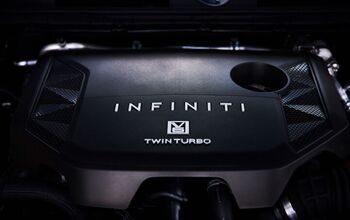

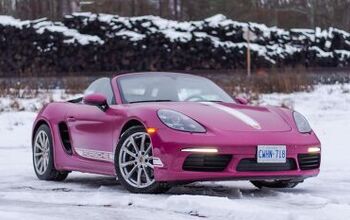

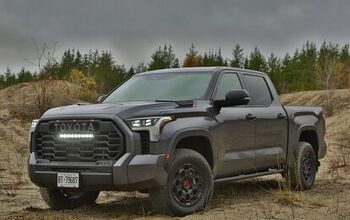



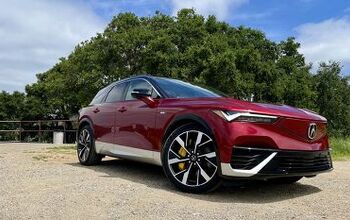
Comments
Join the conversation